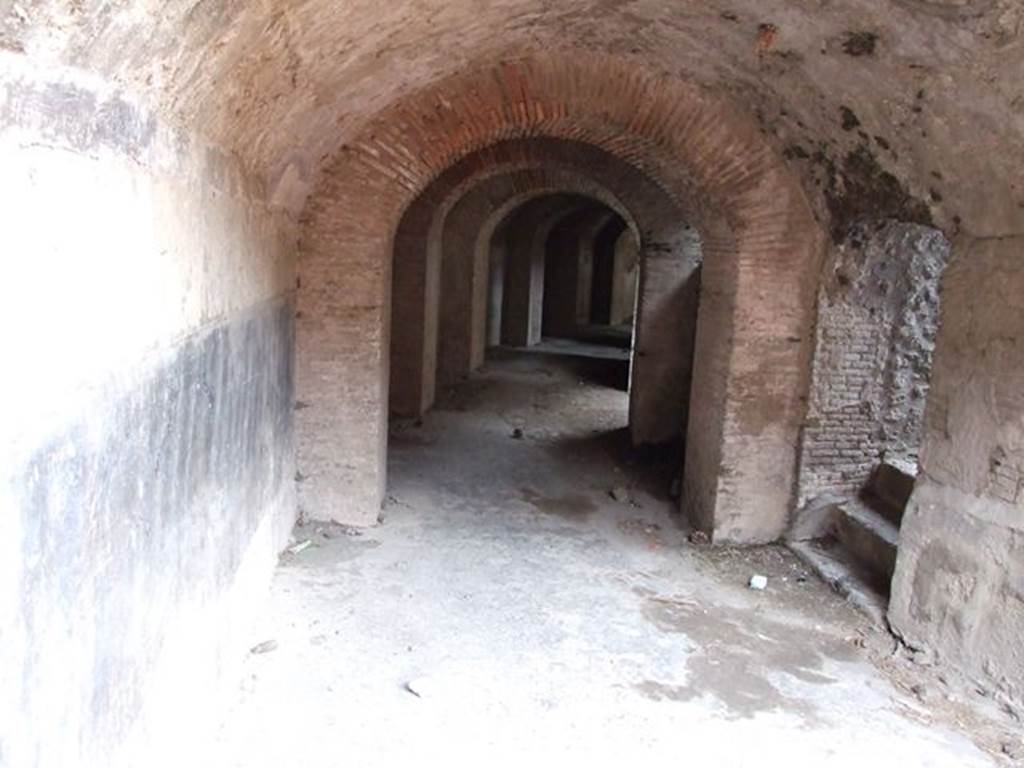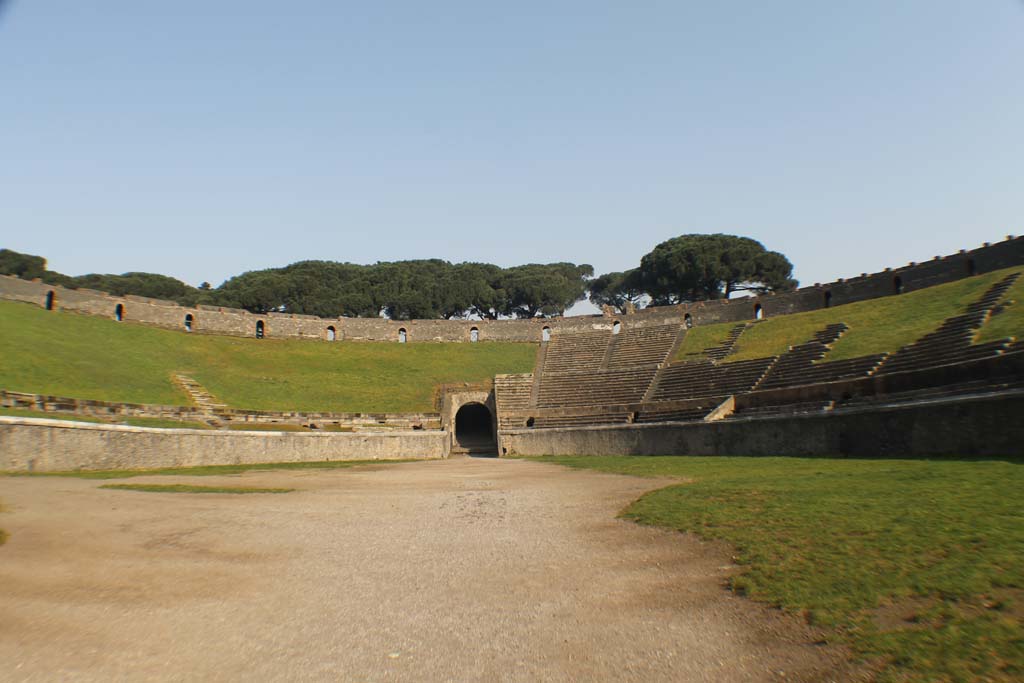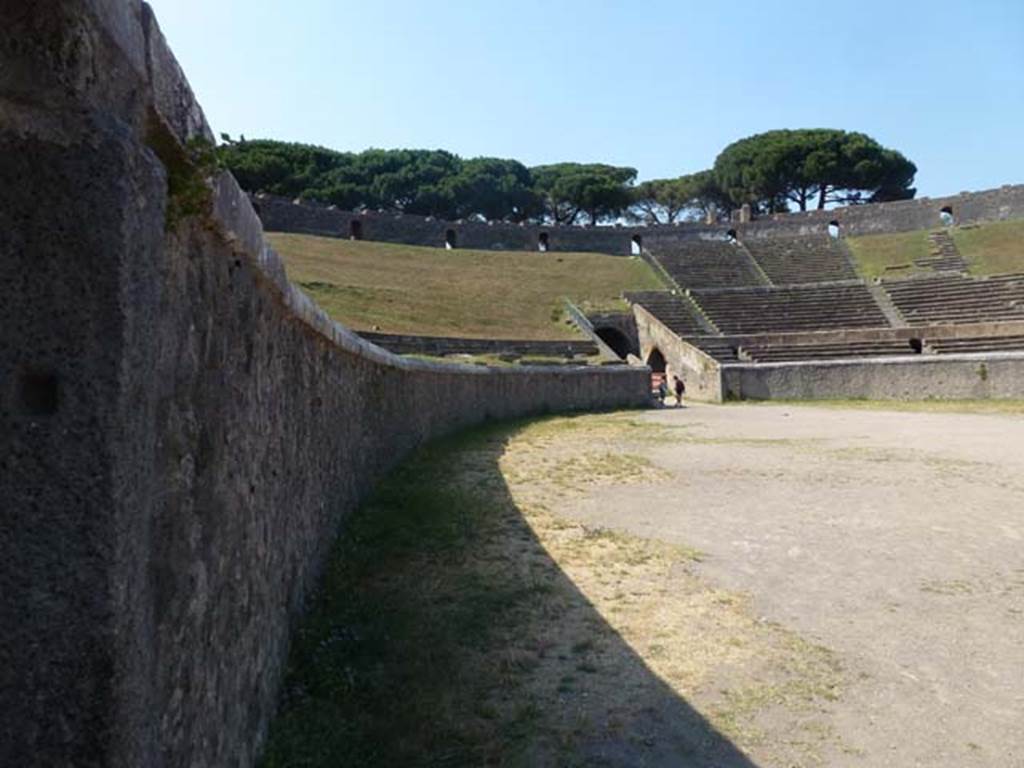II.6 Pompeii. Anfiteatro or
Amphitheatre.
First excavations 1748, then abandoned.
Completely excavated between 1813 and 1816.

II.6 Pompeii, May 2018. North end of Amphitheatre, with steps to upper area. Photo courtesy of Buzz Ferebee.

II.6 Pompeii, March 2014. Upper area of amphitheatre at north end, with rear of Tower VI in centre.
Foto Annette Haug, ERC Grant 681269 DÉCOR.

II.6 Pompeii. September 2005. North end of Amphitheatre.

II.6 Pompeii. September 2005. North entrance of Amphitheatre.

II.6 Pompeii. May 2010. North entrance of Amphitheatre. Photo courtesy of Rick Bauer.

II.6 Pompeii. December 2006. Amphitheatre, northern entrance.
According to Pagano and Prisciandaro, on 29th December 1814 (PAH III, 1), 2 skeletons were found near the doorway that led to the arena.
Near to them were two gold armbands with head of a serpent,
a bracelet, a ring with head of serpent, and a piece of chain used as a
bootlace (un pezzo di cateniglia ad uso di laccettino).
See Pagano, M. and Prisciandaro, R., 2006. Studio sulle provenienze degli oggetti rinvenuti negli scavi borbonici del regno di Napoli. Naples: Nicola Longobardi. (p.110).

II.6 Pompeii. October 2022.
Looking south down sloping corridor towards arena. Photo courtesy of Klaus Heese

II.6 Pompeii. August 2021. Looking south down sloping
corridor towards arena. Photo courtesy of Robert Hanson.

II.6 Pompeii. December 2018.
Looking
south down sloping corridor towards arena. Photo courtesy of Aude Durand.

II.6 Pompeii. December 2006. Looking south.
Amphitheatre showing holes into which stakes carrying barriers were fitted as a means of dividing the corridor when necessary.

II.6 Pompeii. July 2021. Looking towards rectangular
niche on east side of corridor.
Foto Annette Haug, ERC
Grant 681269 DÉCOR.

II.6 Pompeii. July 2021.
East side of amphitheatre corridor, with niche and inscription.
Foto Annette Haug, ERC
Grant 681269 DÉCOR.

II.6 Pompeii. December 2006.
Large rectangular niche, on east side of corridor of Amphitheatre, which had contained a statue of city magistrates.
According to Mau, the niches in the north passage were adorned with two portrait statues of Gaius Cuspius Pansa, father and son.
These were placed in the niches, in the east and west walls, facing each other.
The statues have disappeared, but the inscriptions are still readable.
See Mau, A., 1907, translated by Kelsey, F. W., Pompeii: Its Life and Art. New York: Macmillan. (p. 219).

II.6 Pompeii. August 2021.
Large rectangular niche with inscription, on east side of
corridor.
Foto Annette Haug, ERC
Grant 681269 DÉCOR.

II.6 Pompeii. August 2021.
Inscription below
large rectangular niche on east side of corridor.
Foto Annette Haug, ERC Grant 681269 DÉCOR.

II.6 Pompeii. 2015/2016. Inscription from east side of corridor of Amphitheatre. Photo courtesy of Giuseppe Ciaramella.
![6 Pompeii. December 2006. Inscription from east side of corridor of Amphitheatre. The inscription reads –
C. CVSPIVS C. F. PANSA PATER D. V. I D
IIII. QVINQ. PRAEF. ID. EX. D. D. LEGE. PETRON.
One of two inscriptions to father and son, Cuspius Pansa.
They restored the Amphitheatre at their own expense after the earthquake of AD62.
According to Pagano and Prisciandaro, this read –
C(aius) Cuspius C(ai) f(ilius) Pansa pater d(uum) v(ir) i(ure) d(icundo)
IIII quinq(uennalis) praef(ectus) i(ure) d(icundo) ex d(ecreto) d(ecurionum) lege Petron(i) [CIL X 858] See Pagano, M. and Prisciandaro, R., 2006. Studio sulle provenienze degli oggetti rinvenuti negli scavi borbonici del regno di Napoli. Naples : Nicola Longobardi.
(p.110)](2%2006%2000%20p3_files/image027.jpg)
II.6 Pompeii. December 2006. Inscription from east side of corridor of Amphitheatre. The inscription reads –
C. CVSPIVS C. F. PANSA PATER D. V. I D
IIII. QVINQ. PRAEF. ID. EX. D. D.
LEGE. PETRON.
One of two inscriptions to father and son, Cuspius Pansa.
They restored the Amphitheatre at their own expense after the earthquake of AD62.
According to Pagano and Prisciandaro, this read –
C(aius) Cuspius
C(ai) f(ilius) Pansa pater d(uum) v(ir) i(ure) d(icundo)
IIII
quinq(uennalis) praef(ectus) i(ure) d(icundo) ex d(ecreto) d(ecurionum) lege
Petron(i) [CIL X 858]
See Pagano, M. and Prisciandaro, R., 2006. Studio sulle provenienze degli oggetti rinvenuti negli scavi borbonici del regno di Napoli. Naples: Nicola Longobardi. (p.110)

II.6 Pompeii. July 2021. Looking north along corridor
towards entrance.
Foto Annette Haug, ERC
Grant 681269 DÉCOR.

II.6 Pompeii. September 2024.
Looking south along west wall of corridor. Photo courtesy of Giuseppe Ciaramella.

II.6 Pompeii. July 2021.
Looking towards rectangular niche on west side of corridor.
Foto Annette Haug, ERC Grant 681269 DÉCOR.

II.6 Pompeii. July 2021. West side of corridor with niche
and inscription.
Foto Annette
Haug, ERC Grant 681269 DÉCOR.

II.6 Pompeii. December 2006. Large rectangular niche, on west side of corridor in Amphitheatre.
One of two inscriptions to father and son Cuspius Pansa.
They restored the Amphitheatre at their own expense after the earthquake of AD62.
![II.6 Pompeii. December 2006. Inscription from west side of corridor of Amphitheatre. The inscription reads –
C. CVSPIVS C. F. PANSA PONTIF.
D. VIR I. D.
One of two inscriptions to father and son, Cuspius Pansa.
They restored the Amphitheatre at their own expense after the earthquake of AD62.
According to Pagano and Prisciandaro, this read –
C(aius) Cuspius C(ai) f(ilius) {F} Pansa pontif(ex)
d(uum) vir i(ure) d(icundo) [CIL X 859]
See Pagano, M. and Prisciandaro, R., 2006. Studio sulle provenienze degli oggetti rinvenuti negli scavi borbonici del regno di Napoli. Naples : Nicola Longobardi. (p.110)](2%2006%2000%20p3_files/image035.jpg)
II.6 Pompeii. December 2006. Inscription from west side of corridor of Amphitheatre.
The inscription reads –
C. CVSPIVS C. F. PANSA PONTIF.
D. VIR I. D.
One of two inscriptions to father and son, Cuspius Pansa.
They restored the Amphitheatre at their own expense after the earthquake of AD62.
According to Pagano and Prisciandaro, this read –
C(aius) Cuspius
C(ai) f(ilius) {F} Pansa pontif(ex)
d(uum) vir i(ure)
d(icundo) [CIL X 859]
See Pagano, M. and Prisciandaro, R., 2006. Studio sulle provenienze degli oggetti rinvenuti negli scavi borbonici del regno di Napoli. Naples: Nicola Longobardi. (p.110).

II.6 Pompeii. July 2021. Inscription from west
side of corridor of Amphitheatre
Foto Annette Haug, ERC
Grant 681269 DÉCOR.

II.6 Pompeii. July 2021. Detail of shelf in niche, with inscription
from west side of corridor of Amphitheatre
Foto Annette Haug, ERC
Grant 681269 DÉCOR.

II.6 Pompeii. July 2021. Looking north through the
north entrance corridor.
Foto Annette Haug, ERC
Grant 681269 DÉCOR.

Looking north
through the north entrance corridor. Photo
courtesy of Aude Durand.

II.6 Pompeii. December 2006. Looking north through the north entrance corridor.
The portico entrance of II.5.5 can be seen in the distance.

II.6 Pompeii. July 2021. Looking north towards north
entrance corridor.
Foto Annette Haug, ERC
Grant 681269 DÉCOR.

II.6 Pompeii. April
2022. Looking north towards north entrance corridor. Photo courtesy
of Giuseppe Ciaramella.

II.6 Pompeii. December 2018. Looking north towards north entrance
corridor, from arena. Photo courtesy of Aude Durand.

II.6 Pompeii. August 2021. Looking south towards arena.
Photo courtesy of Robert Hanson.

II.6 Pompeii.
December 2018. Looking
south towards arena from north entrance corridor. Photo courtesy of Aude
Durand.

West corridor under Amphitheatre, looking south-west from north entrance corridor. Photo courtesy of Klaus Heese

II.6 Pompeii. July 2021.
West corridor under Amphitheatre, looking south-west from north entrance corridor.
Foto Annette Haug, ERC Grant 681269 DÉCOR.

II.6 Pompeii. December 2018.
West corridor under Amphitheatre, looking
south-west from north entrance corridor. Photo courtesy of Aude Durand.

II.6 Pompeii. September 2015. West corridor under Amphitheatre, looking south-west from north entrance corridor.

II.6. Pompeii. September 2015. Detail of west corridor, visible at far end from north entrance corridor.
![II.6 Pompeii. December 2006. West corridor under Amphitheatre, looking south-west. According to Pagano and Prisciandaro, graffiti were found here, some painted in red and some in black.
Found 24th November 1814 (PAH I, 3,165, III,1) –
Omnia munera vicisti
ton henta theamaton est [CIL IV 1111 painted in black]
Abdili Eh habes
te bene [CIL IV 1112]
Sabinum [CIL IV 1113]
Found 27th November 1814, (PAH I, 3, 165, III,1) painted in red, but hardly readable –
Olio M()
Feliciu
Lyxania
Stephanio
/
Simicrito amor CRINRIN
VAVRIVS [CIL IV 1114]
Found 1st December 1814, (PAH I, 3, 166, III,1* - *27th November) painted in red –
Laelius Narcissus occupant [CIL IV 1115]
Popidium Ruf(um)
A<e=B>dili rei [CIL IV 1116]
See Pagano, M. andPrisciandaro, R., 2006. Studio sulle provenienze degli oggetti rinvenuti negli scavi borbonici del regno di Napoli. Naples : Nicola Longobardi. (p.112)](2%2006%2000%20p3_files/image056.jpg)
II.6 Pompeii. December 2006. West corridor under Amphitheatre, looking south-west.
According to Pagano and Prisciandaro, graffiti were found here, some painted in red and some in black.
Found 24th November 1814 (PAH I, 3,165, III,1) –
Omnia munera
vicisti
ton henta
theamaton est [CIL IV 1111 painted in
black]
Abdili Eh
habes
te bene [CIL IV 1112]
Sabinum [CIL IV 1113]
Found 27th November 1814, (PAH I, 3, 165, III,1) painted in red, but hardly readable –
Olio M()
Feliciu
Lyxania
Stephanio
/
Simicrito amor
CRINRIN
VAVRIVS [CIL IV 1114]
Found 1st December 1814, (PAH I, 3, 166, III,1* - *27th November) painted in red –
Laelius Narcissus
occupant [CIL IV 1115]
Popidium Ruf(um)
A<e=B>dili
rei [CIL IV 1116]
See Pagano, M. and Prisciandaro, R., 2006. Studio sulle provenienze degli oggetti rinvenuti negli scavi borbonici del regno di Napoli. Naples: Nicola Longobardi. (p.112)

II.6 Pompeii. September 2024.
Corridor under amphitheatre, with “Pink Floyd” exhibition. Photo courtesy of Giuseppe Ciaramella.

II.6 Pompeii. September 2024. Amphitheatre
steps. Photo courtesy of Giuseppe Ciaramella.

II.6 Pompeii. July 2021. East corridor under Amphitheatre, looking south-east from north entrance corridor.
Foto Annette Haug, ERC
Grant 681269 DÉCOR.

II.6 Pompeii. May 2017.
East corridor under Amphitheatre, looking south-east from north entrance corridor. Photo courtesy of John Puffer.

II.6 Pompeii. May 2016.
East corridor under Amphitheatre, looking south-east from north entrance corridor. Photo courtesy of Buzz Ferebee.

II.6 Pompeii. September 2015. East corridor under Amphitheatre, looking south-east from north entrance corridor.

II.6 Pompeii. September 2015. North wall of east corridor under Amphitheatre.

II.6 Pompeii. December 2006. East corridor under Amphitheatre, looking south-east.

II.6 Pompeii. December 2018. Looking towards west side of entrance
corridor from the north. Photo courtesy of Aude Durand.

II.6 Pompeii. December 2006. Doorway to underneath of Amphitheatre, on west side of entrance corridor from north.
According to Mau, there are three of these small dark rooms, near the end of the three corridors.
Their purpose was unknown, but they may have been storerooms.
See Mau, A., 1907, translated by Kelsey, F. W., Pompeii: Its Life and Art. New York: Macmillan. (p. 215-6).

II.6 Pompeii. December 2006. Small dark room on west side of entrance corridor of Amphitheatre, possibly a storeroom.

II.6 Pompeii. August 2021. Looking towards north
end of arena of amphitheatre. Photo courtesy of Robert Hanson.

II.6 Pompeii. March 2014. Looking towards north entrance corridor.
Foto Annette Haug, ERC
Grant 681269 DÉCOR.

II.6 Pompeii. 2015/2016. Looking
towards north end of arena of amphitheatre. Photo courtesy of Giuseppe
Ciaramella.

II.6 Pompeii. June 2012. Looking towards north end of arena of amphitheatre. Photo courtesy of Michael Binns.




II.6 Pompeii. September 2024.
Looking west across amphitheatre towards site of preview/rehearsal for a larger event, including Gladiators and Roman Soldiers.
Photo courtesy of Giuseppe Ciaramella.

II.6 Pompeii. September 2024.
Looking west across amphitheatre towards Gladiators in combat rehearsing.
Photo courtesy of Giuseppe Ciaramella.

II.6 Pompeii. September 2024.
Looking west towards Gladiators in combat rehearsing.
Photo courtesy of Giuseppe Ciaramella.

II.6 Pompeii. September 2024.
Gladiators in
combat rehearsing in amphitheatre. Photo courtesy of Giuseppe Ciaramella.
II.6 Pompeii. Modern drawings of various types of gladiators showing typical armour and weapons.
Eques ("horseman")
Hoplomachus ("heavy-weapons fighter")
Murmillo ("fish")
Provocator ("attacker")
Retiarius ("netman")
Secutor ("pursuer")
Thraex ("Thracian").
Photo courtesy of Barbara McManus.

II.6 Pompeii. September 2024.
Roman Soldiers –
Legio IX Hispana - on the march. Photo courtesy of Giuseppe Ciaramella.

II.6 Pompeii. September 2024. Roman Soldiers – Legio IX Hispana – rehearsing. Photo courtesy of Giuseppe Ciaramella.

II.6 Pompeii. September 2024. Roman Soldiers – defensive action – forming a side of the Square.
The hollow square was the formation used to resist/repel cavalry.
The legionaries would assume a square formation, holding their pila as spears in the space between their shields and strung together shoulder to shoulder. No matter which side the cavalry attacked from, they would be met with a wall of sharp spearheads.
A square formation was
also the typical shape of a century in battle.
Photo courtesy of Giuseppe Ciaramella.

II.6 Pompeii. September 2024. Roman Soldiers – attacking action – testudo/tortoise formation.
This was slow-moving, but almost impenetrable to enemy fire, and thus very effective during sieges and/or when facing off against enemy archers.
Cohorts approached the city's wall in testudo formation, bringing up battering rams and ladders to breach the gates and scale the walls.
However, the testudo formation did not allow for effective close combat – therefore it was used only when the enemy were far enough away.
Photo courtesy of Giuseppe Ciaramella.

II.6 Pompeii. 1961. Preparations for a medieval mystery play to be performed here at the north end. Photo by Stanley A. Jashemski.
Source: The Wilhelmina and Stanley A. Jashemski archive in the University of Maryland Library, Special Collections (See collection page) and made available under the Creative Commons Attribution-Non-Commercial License v.4. See Licence and use details.
J61f0253

II.6 Pompeii. 1961.
South end of amphitheatre, man in white with banner leading the parade for the performance of the mystery play.
Photo by Stanley A. Jashemski.
Source: The Wilhelmina and Stanley A. Jashemski archive in the University of Maryland Library, Special Collections (See collection page) and made available under the Creative Commons Attribution-Non-Commercial License v.4. See Licence and use details.
J61f0275

II.6 Pompeii. 1961.
South end of amphitheatre, four lancers marching four abreast in the parade for the performance of the mystery play.
Photo by Stanley A. Jashemski.
Source: The Wilhelmina and Stanley A. Jashemski archive in the University of Maryland Library, Special Collections (See collection page) and made available under the Creative Commons Attribution-Non-Commercial License v.4. See Licence and use details.
J61f0277

II.6 Pompeii. March 2014. Looking north-west across arena.
Foto Annette Haug, ERC
Grant 681269 DÉCOR.

II.6 Pompeii, May 2018. Detail of seating on west side of north entrance to amphitheatre. Photo courtesy of Buzz Ferebee.
